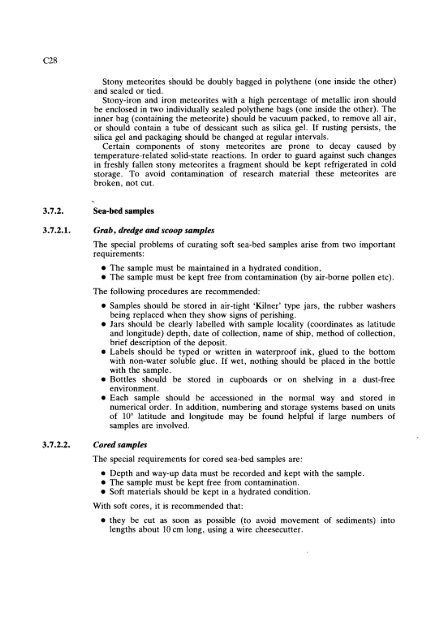GUIDELINES FOR THE CURATION OF GEOLOGICAL MATERIALS
GUIDELINES FOR THE CURATION OF GEOLOGICAL MATERIALS
GUIDELINES FOR THE CURATION OF GEOLOGICAL MATERIALS
You also want an ePaper? Increase the reach of your titles
YUMPU automatically turns print PDFs into web optimized ePapers that Google loves.
Stony meteorites should be doubly bagged in polythene (one inside the other)<br />
and sealed or tied.<br />
Stony-iron and iron meteorites with a high percentage of metallic iron should<br />
be enclosed in two individually sealed polythene bags (one inside the other). The<br />
inner bag (containing the meteorite) should be vacuum packed, to remove all air,<br />
or should contain a tube of dessicant such as silica gel. If rusting persists, the<br />
silica gel and packaging should be changed at regular intervals.<br />
Certain components of stony meteorites are prone to decay caused by<br />
temperature-related solid-state reactions. In order to guard against such changes<br />
in freshly fallen stony meteorites a fragment should be kept refrigerated in cold<br />
storage. To avoid contamination of research material these meteorites are<br />
broken, not cut.<br />
-<br />
Sea-bed samples<br />
Grab, dredge and scoop samples<br />
The special problems of curating soft sea-bed samples arise from two important<br />
requirements:<br />
The sample must be maintained in a hydrated condition,<br />
The sample must be kept free from contamination (by air-borne pollen etc).<br />
The following procedures are recommended:<br />
Samples should be stored in air-tight 'Kilner' type jars, the rubber washers<br />
being replaced when they show signs of perishing.<br />
Jars should be clearly labelled with sample locality (coordinates as latitude<br />
and longitude) depth, date of collection, name of ship, method of collection,<br />
brief description of the deposit.<br />
Labels should be typed or written in waterproof ink, glued to the bottom<br />
with non-water soluble glue. If wet, nothing should be placed in the bottle<br />
with the sample.<br />
Bottles should be stored in cupboards or on shelving in a dust-free<br />
environment.<br />
Each sample should be accessioned in the normal way and stored in<br />
numerical order. In addition, numbering and storage systems based on units<br />
of 10" latitude and longitude may be found helpful if large numbers of<br />
samples are involved.<br />
Cored samples<br />
The special requirements for cored sea-bed samples are:<br />
Depth and way-up data must be recorded and kept with the sample.<br />
The sample must be kept free from contamination.<br />
Soft materials should be kept in a hydrated condition.<br />
With soft cores, it is recommended that:<br />
they be cut as soon as possible (to avoid movement of sediments) into<br />
lengths about 10 cm long, using a wire cheesecutter.

















